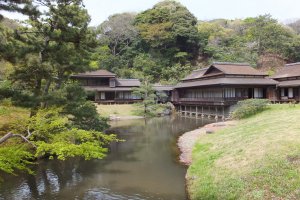Yokohama is covered with beautiful parks and gardens. One of my favorites, Sankeien Garden, is not only nicely landscaped but provides a history lesson from the Muromachi era all the way to the Showa era.

The garden was built in the traditional Japanese style by Tomitaro Hara (also known as Sankei) and opened in 1906. It is comprised of 43 acres of ponds, streams, and very nice walking paths, all of which were designed by Mr. Hara. Sankeien was built into two sections the inner and outer garden. The inner garden was the Hara family’s private area. Make sure you stop by the museum and watch the video about Sankei Hara. He was a very special entrepreneur and right after the Great Earthquake gave his time and resources to help rebuild Yokohama. Though the garden itself did survive the Great Kanto Earthquake and WWII bombings, it underwent a full restoration in the mid-1950s.

Ten of the garden's buildings were declared Important Cultural Property; three more are Tangible Cultural Properties of Japan. Mr. Hara relocated these buildings from Kamakura, Kyoto, Tokyo, Gifu Prefecture, and Wakayama Prefecture. The pagoda that sits on the hill was built in 1457 and moved from Kyoto in 1914.

When you arrive at the entrance, ask for the current brochure with the schedule of buildings that are open to the public. Currently, the only one open year-round is the former Yanoharake House. I recently toured the house with a very nice Japanese gentleman who explained the history to me in English. It was originally built in the small village of Shirakawa-go in Gifu Prefecture.

I had the privilege to visit this UNESCO World Heritage village a few years ago but was unable at the time to ask questions about the construction. The gentleman at Sankeien was more than happy to answer them for me. He told me the thatched roofs last a little over twenty years before they have to be replaced. There are no nails used in the construction, but rather, intricate cuts in the wood allow for a clean fit and a solid long-lasting structure. This house has the original fireplace, bathroom, and kitchen. I noticed the unique floral arrangement in the center of the room.
Winter in Shirakawa is very extreme and the residents like to present flowers as an offering at the temple year-round. Since nothing is growing during wintertime, they take branches with rice mochi and create a very nice floral arrangement that is offered up to the gods.

Check the blooming and event brochure for a schedule of what flowers will be available during your visit. They include daffodils, camellias, plum blossoms, cherry blossoms, wisteria, iris, roses, lilies, lotuses and many more.
The garden is open daily from 9:00 to 17:00, except for December 29 -31.
The entrance fee is only ¥500 or about USD$4.40.
This is just one of hundreds of interesting places you will find when visiting Yokohama and if you would like to spend a night around there, Hotel MyStays Yokohama Kannai will be a great choice.





































